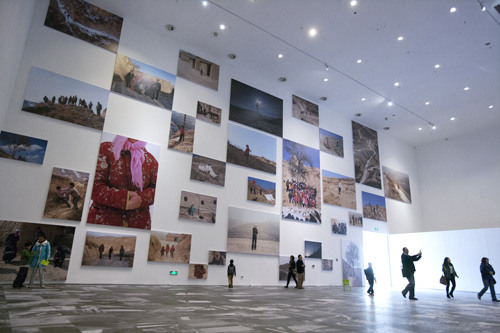|
 |
|
HIDDEN ART: The Hidden Land exhibition opens in the Today Art Museum in Beijing on April 7 (WANG XIANG) |
Organizers prepared five pocket cameras for the villagers, each worth about 700 yuan ($113). Except for teaching villagers the basic skills, they provided no guidance on composition or selection of subjects, just asking them to snap photos of whatever suited their fancy.
On the evening of December 15, after a day of shooting, they made the first display of the pictures both from visiting photographers and villagers. The villagers' works awed almost everybody present.
"The photographers often gasped at the display of the villagers' pictures," said Chen. "It is unexpectedly awesome."
Five-year-old Ma Xiaofu is only 1.2 meters tall and his pictures are all at the height of his eyes. People in his pictures mostly have neither head nor feet. But this created a novel visual effect.
Eleven-year-old Ma Qin's pictures are all about her female friends. None of the girls posed for the camera—they either hide behind a blurred window, or jump on piles of straw or just show a hand in the sunshine.
Ma Shenghua is the only teacher in the village's primary school, which had less than 30 students. She took photos of her students. Most of the kids have never seen cameras before so they appear more candid than kids who are more used to putting on a face.
"The kids might not look so natural in the photographers' cameras," said Zang. "Photographers are always inclined to tell everybody they are camera carriers and they are professional, which is more like an obstacle."
The photographic program in Shangjuanzu lasted for four months until March. In addition to more than 80 artists from across the country, 29 local villagers also participated, the youngest being 4 years old and the oldest 67.
Photographer Bai Dongquan said that he learned a lot from the villagers' pictures although they sometimes made him feel kind of frustrated. "After years of professional experience, I never thought pictures can be taken with so many different and interesting angles," he said.
Bai got up very early every morning in the village and worked very hard to take pictures. So did his companions. "Some of the photographers took their best works ever in the village."
From village to Beijing
On April 7, before participating villagers moved to their new houses in another town, they took a slight detour to Beijing, more than 1,000 km away. Their works were shown at a large photo exhibition entitled Hidden Land.
The exhibition displayed 2,600 pictures from both Shangjuanzu villagers and professional photographers in the four-story museum. Villagers played a major role in planning, too, selecting their favorites first and letting the professionals help to choose the rest.
Villagers' choice is mostly based on their feelings to the subject of the pictures—the cat, the dog, the tree in the courtyard, the farmland or food they like most.
"Judging solely by professional standards, most of the villagers' works are not qualified to be exhibited, but they are so vivid that you will forget all those criteria," said photographer Pan Ke.
Natasha Murray, an Australian freelance photographer visited the exhibition and was strongly impressed. "It is just amazing what they have done in the village and I really hope I can participate in such a program in the future," said Murray.
"All the surprises, in a way, come from the large gap between these two groups and the low expectations of the villagers' works at the beginning," said Hai Jie, a photographic critic.
"We don't want to draw any conclusion from this experiment and we want to leave it to the audience to decide," said Wang Zheng. "This is just a start of the following activities we are going to take."
Email us at: yuanyuan@bjreview.com | 